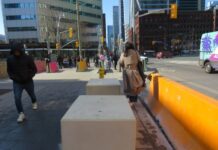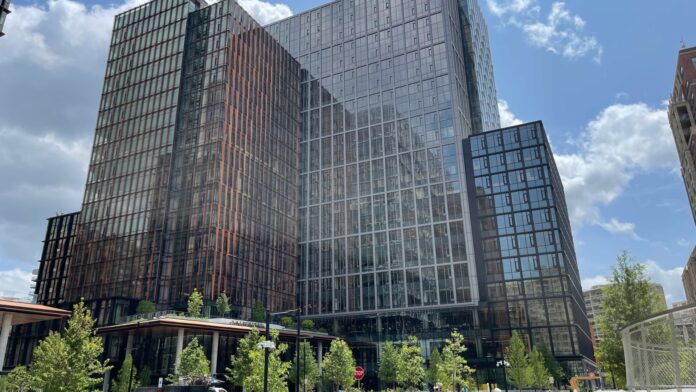Starting next week, the first of 8,000 Amazon employees will begin moving into one of two brand new 22-story skyscrapers in Arlington, Virginia. The move-in should be completed by the end of the summer. Officially called Metropolitan Park, Amazon’s headquarters has many features that contribute to the company’s goal of achieving net-zero carbon emissions in all operations by 2040.
The buildings operate with zero operational carbon emissions and are powered by 100% renewable energy from a nearby solar farm.
“We’ve gone fossil-fuel free from this building, which is huge and really new for many developments, especially this size,” said Kara Hurst, vice president of global sustainability at Amazon.
The 2.1 million square foot space incorporates some of the latest clean energy technologies and sustainability features. A huge meeting room has a solid wood ceiling made from 70 feet of laminated boards made from sustainable material. The floor is made of concrete from Carbon Cure, a clean cement company funded by Amazon’s Climate Pledge Fund.
A meeting room at Amazon HQ2
Diana Olick | CNBC
There are 3,000 tinted glass windows for cooling and red/green lights on the side of the windows that tell workers when it’s a good time to open the windows. The building also uses special cooling technology that helps save approximately 7.5 million gallons of water per year. That’s more water than is needed to fill the reflecting pool at the Lincoln Memorial.
The heating and cooling systems work according to demand, which means that ventilation and temperatures change depending on occupancy. In addition, there are advanced energy measurement systems in the building to help evaluate future improvements once the building is occupied and teams are using the space.
“I think it’s incredibly important for a company like Amazon to demonstrate leadership and sustainability and to be out there talking about where we’re testing and testing things to also send demand signals to the market that it’s about products and services that we want.” Hurst said. “We want to see the innovation in construction materials. We want to see the innovation in construction equipment. We want to see it in how we integrate that, and we want that in happens on a large scale, partly for reasons of cost parity, but also partly for reasons of availability for all.”
Hurst wouldn’t say how much the sustainability features increased development costs. Amazon officials said only that a few things had proven to be cost-neutral, such as the low-carbon concrete.
“Other decisions have revolved around long-term benefits, such as our water conservation efforts. Sustainability also goes beyond making operational cost savings decisions,” the officials said.
The development was designed in close consultation with the surrounding community. The dog parks and daycare center in the complex are open to surrounding residents. There is also a vegetable garden on the roof of the new tower which is now opening and is not intended for employees. Instead, the food produced is distributed to local community organizations through non-profit organizations.
Still, there are plenty of conveniences for the 8,000 employees, who Hurst says will be in the office at least three days a week.
“We remain committed to all of the hiring goals we have set. So we will continue down this path, but over the course of the next decade,” Hurst said.
As for the second phase of the HQ2 offices, which was recently postponed, Hurst declined to give a timeframe, but said Amazon is in the pre-construction phase and remains interested.















